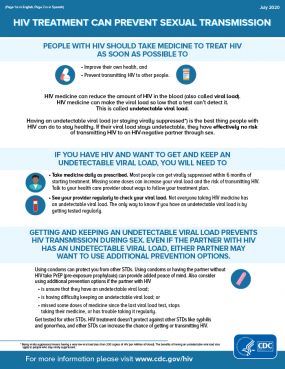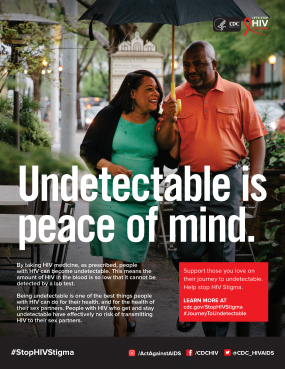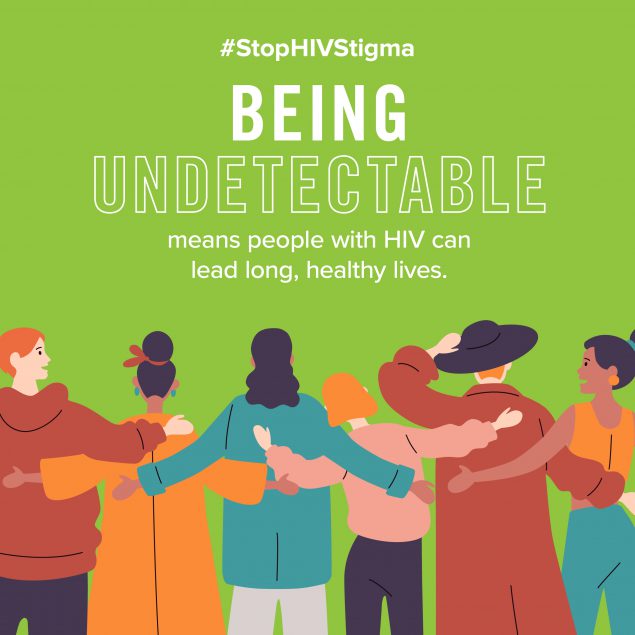HIV Treatment as Prevention
Overview
People with HIV should take medicine to treat HIV as soon as possible. HIV medicine is called antiretroviral therapy, or ART. If taken as prescribed, HIV medicine reduces the amount of HIV in the body (viral load) to a very low level, which keeps the immune system working and prevents illness. This is called viral suppression—defined as having less than 200 copies of HIV per milliliter of blood. HIV medicine can even make the viral load so low that a test can’t detect it. This is called an undetectable viral load.
Getting and keeping an undetectable viral load* is the best thing people with HIV can do to stay healthy. Another benefit of reducing the amount of virus in the body is that it helps prevent transmission to others through sex or syringe sharing, and from mother to child during pregnancy, birth, and breastfeeding. This is sometimes referred to as treatment as prevention. There is strong evidence about treatment as prevention for some of the ways HIV can be transmitted, but more research is needed for other ways.

A person with HIV who takes HIV medicine as prescribed and gets and stays virally suppressed or undetectable can stay healthy and has effectively no risk of sexually transmitting HIV to HIV-negative partners.
Risk of HIV Transmission With Undetectable Viral Load by Transmission Category
| Transmission Category | Risk for People Who Keep an Undetectable Viral Load |
|---|---|
| Sex (oral, anal, or vaginal) | Effectively no risk |
| Pregnancy, labor, and delivery | 1% or less† |
| Sharing syringes or other drug injection equipment | Unknown, but likely reduced risk |
| Breastfeeding | Substantially reduces, but does not eliminate risk. Current recommendation in the United States is that mothers with HIV should not breastfeed their infants. |
† The risk of transmitting HIV to the baby can be 1% or less if the mother takes HIV medicine daily as prescribed throughout pregnancy, labor, and delivery and gives HIV medicine to her baby for 4-6 weeks after giving birth.
Resources for Providers
HIV Transmission Prevention: Information for Health Care Providers
Earn Free CME Credits and CE Units: https://www.staging.medscape.org/viewarticle/915551external icon
The goal of this activity is to improve knowledge regarding the benefits of treatment as prevention (TasP) for patients living with HIV and the best practices for implementing TasP in clinical practice.
Resources for Consumers
Download Social Media
1-800-933-3413
9 a.m. – 8 p.m. ET, Monday – Friday
For more information, visit the National Clinicians Consultation Centerexternal icon.
National Clinicians’ Post-Exposure Prophylaxis Hotline (PEPline) 1-888-HIV-4911 (1-888-448-4911) 9 a.m. – 8 p.m. ET, Monday – Friday; 11 a.m. – 8 p.m. ET, weekends and holidays
National Perinatal HIV Consultation and Referral Services (Perinatal Hotline) 1-888-HIV-8765 (1-888-448-8765) 24 hours a day, seven days a week
National Pre-Exposure Prophylaxis Consultation (PrEPline) 1-855-HIV-PREP (1-855-448-7737) 9 a.m. – 8 p.m. ET, Monday – Friday
*The benefits of having an undetectable viral load also apply to people who stay virally suppressed.













